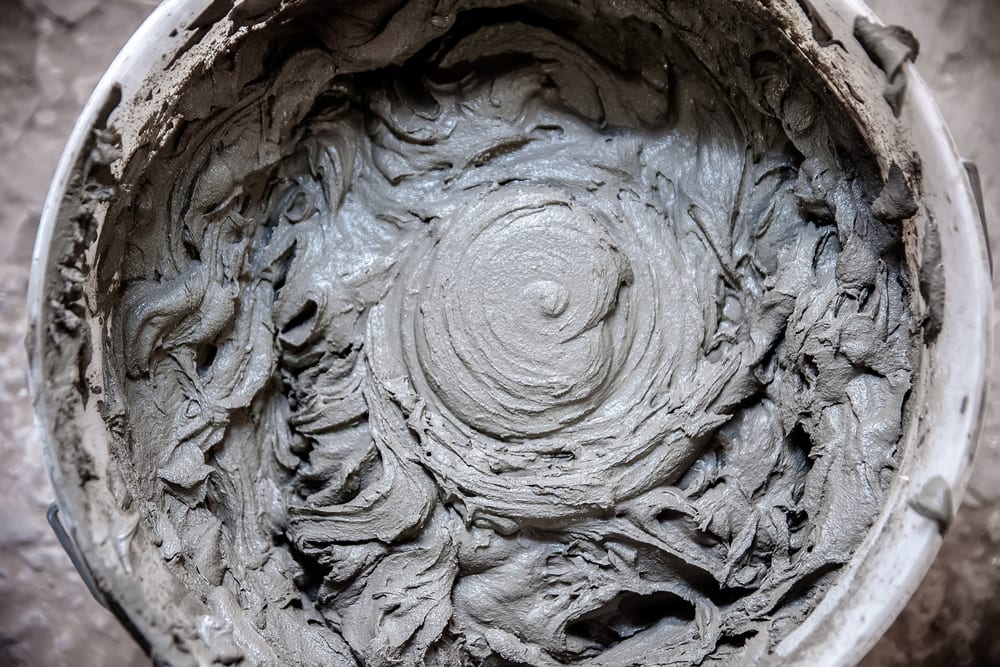TECH FOCUS:
Time Savers: Three Grout & Adhesive Technologies for the Dynamic Tiler
BY: John McIntyre

// Efflorescence is the emergence of minerals (most commonly salt) to the grout surface. Photo: Sika.
Time Savers: Three Grout & Adhesive Technologies for the Dynamic Tiler
Time is money, so the aphorism goes. It holds true across virtually any line of business. However, it holds special significance for our tiling industry, where cleanup, wait times and unscheduled calls back to projects consume large portions of time better spent driving new business. Fortunately, the more forward-thinking manufacturers of tile-setting materials are driving new technologies that help reclaim lost time, improve jobsite conditions and impart greater flexibility in the process. Below are new adhesive and grout technologies that every dynamic tiler needs to start adding to their materials lists to take their productivity to the highest level.

// Dustless grouts and adhesives save countless hours otherwise spent setting up, mixing and cleaning — time that could be focused on new business. Photo: Sika.
Dustless Technology
Adhesive and grout dust has long been an unavoidable part of nearly any tiling project. The cementitious nature of the products creates thick clouds of dust whenever they are disturbed, such as during opening, pouring and mixing. On a good day, dust will simply settle around the jobsite, necessitating a more involved cleanup at the end of the project. On other days, this dust will embed in clothes, shoes and sinuses, as well as find its way into ventilation ducts, tools and machinery vents.
Ways around creating dusty messes have included mixing adhesives and grouts outside. While effectively keeping the jobsite clean, the many back-and-forth trips hauling mixed materials make this a tediously backbreaking choice, especially when flights of stairs are involved. Another option was to introduce an OSHA-compliant HEPA dust collector to the jobsite, but these devices are quite costly and complicate the logistics of a tiling project. With no good solution available, the industry needs grout and adhesive products that are just less dusty.
There is good news. There are newer brands of grouts and adhesives that are purposely formulated to eliminate most dust during use. In addition to cleaner, more breathable workspaces, SikaTile dustless products have other key advantages for the tiling community. For starters, they require less water for mixing. Their formulas also give them longer pot lives and creamier consistencies that glide much easier when troweling. Dustless grouts and adhesives save countless hours otherwise spent setting up, mixing and cleaning — time that could be focused on new business.

// No-slake products require no wait time, no final mix. Photo: Sika.
Efflorescence-Free Technology
Few things pull an installer back to an installation more than calls about efflorescence. Efflorescence is the emergence of minerals (most commonly salt) to the grout surface. As cementitious grouts and adhesives dry, the evaporation creates microscopic capillary networks throughout the materials. The capillary action brings moisture and water-soluble minerals to the surface. The minerals form a whitish, powdery crust on the grout that detracts from the installation’s appearance and can require strong chemicals to remove.
Efflorescent-free grouts keep finished surfaces clear of mineral deposits. Products like SikaTile-815 Secure Grout removes efflorescence from the equation entirely. The unique formula forgoes many of the components that form crystals, while a quicker hydration process closes the capillary holes before vapors and salts can reach the surface. Along with efflorescence-free results, it preserves installation elegance through stain resistance, color consistency and mold/mildew prevention, saving tilers from calls back to the jobsite.
No-Slake Technology
Waiting as tile-setting materials slake is precious time lost. This time quickly adds up in relation to the amount of product used. Most materials need to rest five to 15 minutes after initial mixing to allow the dry polymers and/or pigments to hydrate before a final mix. That may not seem like much time, but when you think in terms of each 48-bag pallet used, that’s up to 12 hours potentially lost playing the waiting game. This figure compounds greatly as the size of the installation increases.
No-slake products require no wait time, no final mix. SikaTile adhesives and grouts hydrate with a single mix and are instantly ready to apply. Unique dry-polymer properties lend no-slake properties to the easy-to-use materials to speed up interior and exterior applications. This can shave several hours off tiling applications, freeing up crews to tackle the next project.
Time = Money
By familiarizing oneself with and adopting new time-saving technologies, tilers instantly increase productivity and add value to the jobsite. The time gains create newfound flexibility for scheduling installations and open far more slots to accommodate new customers. On the flipside of the coin, the shorter installation periods reduce the disruption to the customer, building the dynamic tiler’s reputation as a time-conscious partner.
The materials to speed up business are there. If you haven’t found your reason to start using them yet, well, time’s a-wastin’.

John McIntyre is a National Technical Manager for Sika. His construction professional experience began in his teens and has taken him through all avenues of the tiling industry. Following nearly a decade in tile materials distribution and manufacturing, McIntyre served in technical sales for tile setting materials manufacturer Merkrete until 2020. Aside from his duties at Sika, McIntyre devotes his time evaluating CTIs for CTEF.
About the Author >>
